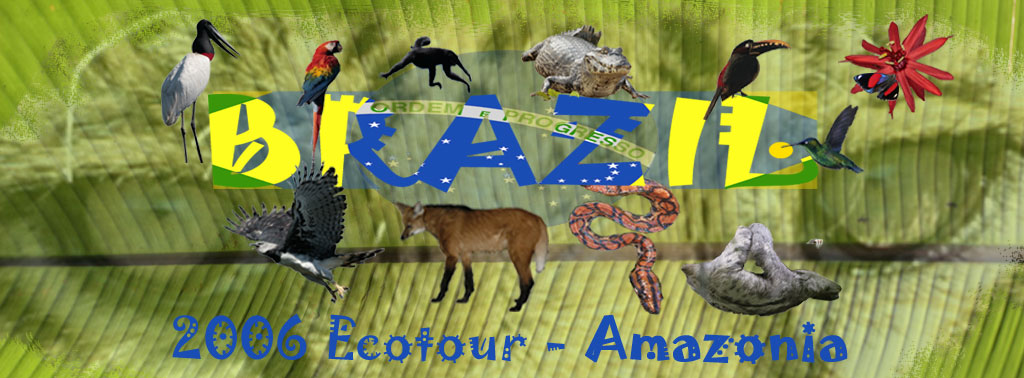



Added 3 September 2006
Day 10: Thursday, June 15, 2006
On Thursday we woke early to continue our trip back to Cuiabá, where we would catch our flight to Alta Floresta and the Amazon. The reason for us leaving early was to have some time in Cuiabá to try to find a power adaptor for the camcorder.
Along the way we saw a jaguarundi run across the road ahead of us. It was such a brief encounter that if it weren't for the distinctiveness of the jaguarundis form, I would never have known what it was.
I got great amusement from Shan on the way as well. The driver kept spitting out the window, and part of it kept blowing back in the van and hitting Shan. (Don't worry, that's not the funny part, even I'm not that sadistic.) Anyway, Shan was really anxious to get to Cuiabá to look for the camcorder charger, and the driver seemed to be going slower than he could have gone, so she wasn't happy with him to begin with, and the whole spit thing really bent her out of shape. I tried to calm her down a bit, as it seemed clear that the driver had no clue what was happening, but the fact remained that she kept getting hit with spit.
After a while, (and this is the funny part) every time the driver even cleared his throat, Shan dove for the deck like she'd just heard a mortar round coming at her. I couldn't help but laugh every time it happened, and even Shan I think eventually saw the humor in it.
Eventually we did make it to Cuiabá, which made Shan happy. Unfortunately, it was a holiday, so our options for finding a charger were limited. Fabricio took us to a market that he knew of where "you can get anything," but we didn't have any luck there. We then went to a photo shop, but it ended up being a photo developing place. We continued on to another market, similar to the first, with many vendors in stalls in a big building.
At first it looked like we weren't going to have any luck at all. Then Shan came back with a lead. We hurried to a stall where someone had camcorders. They didn't have any Canon products at all though, and they had no chargers by themselves. Desperate, and wanting to right the wrong I did, I thought about just buying a camcorder to use for the rest of the trip, which I could sell upon returning to the US so I wouldn't take such a huge loss. They even had a Sony camcorder, albeit without documentation, that I had researched and new the value of, so I asked how much it was.
The man said it was R$1200, or roughly US$600. I could buy the same camcorder new for under US$300 at almost any store in the US. I would have taken a real beating on it had Shan said she wanted it. Even as much as she wanted her camcorder, she wasn't willing to spend that much money. So we continued on in search of a simple charger that would work.
Just as we were running out of time to get to the airport, and just as I was about to call it quits, I saw something that looked promising. It was a universal adaptor with adjustable settings. The vendor had them in car charger and wall charger models. The voltage settings weren't exactly what the camera called for, but we tried both and they seemed to work! With them plugged them in, the charging light blinked and I could power the camera on. I even unplugged the camera and powered the camera on from the battery briefly just to be certain. I was elated with this success. So I happily bought the wall charger and we went to the airport.
Later that day after we arrived at the Rio Cristalino Jungle Lodge, I plugged the camcorder into the wall and notice that the battery charge light seems to be blinking rather quickly. I check the manual, and the battery isn't accepting the charge. I fiddle with it. I try the other battery. I unplug it and try to turn the camera on. It doesn't work. I plug it back in and turn the camera on. It powers up just fine. The charger ended up being close enough to the right voltage to run the camera, but not close enough to charge the batteries. Apparently, back in Cuiabá, the battery had just enough charge in it to power the camera for a few seconds as I tested it. So despite my best efforts to correct the problem, without a very long extension cord, I was defeated. The camcorder became nothing more than an expensive and somewhat fragile consumer of precious luggage space.
Going back to Cuiabá. . . We made it to the airport, as it turns out, with more time to spare than we wish we'd had. We had a couple of small scares at the airport though. Our flight to Alta Floresta, though booked through TAM, was operated by Tryp Airline. So while Chuck, Dave, Shan and I got our tickets at the TAM ticket counter, Fabricio had to get his at the Tryp ticket counter. The first scare was that Tryp Airline overbooked the flight and bumped Fabricio from the flight. He had to argue that he was escorting tourists to Alta Floresta and eventually Tryp bumped someone else. My guess is that he told them stories about Shan's mishaps and was thus able to convince them that we'd all die if he weren't there to take care of us. With our flight leaving soon, we got in the long line to go through security, a bit concerned that the line might not move fast enough for us to make our flight (scare #2).
The next scare occurred when Shan and I tried to go through security and our tickets wouldn't scan. At this point, our flight was due to leave very shortly. Fabricio grabbed our tickets and went back to the Tam ticket counter. He returned shortly with fixed tickets, saving the day once again!
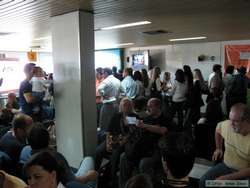 Then we got to the crux of the statement I made earlier about getting to the airport too early, for we found ourselves stuck in a crowded, hot, muggy room with our plane nowhere in sight. I'm sure the wait wasn't nearly as long as it seemed to be, but in any case, except for the company we kept, it wasn't a pleasant wait.
Then we got to the crux of the statement I made earlier about getting to the airport too early, for we found ourselves stuck in a crowded, hot, muggy room with our plane nowhere in sight. I'm sure the wait wasn't nearly as long as it seemed to be, but in any case, except for the company we kept, it wasn't a pleasant wait.
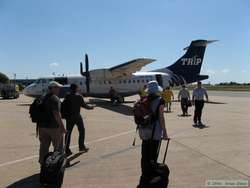 When the plane arrived and we were allowed to board, we walked out onto the tarmac and found that our transport would be a twin engine propeller plane, albeit a rather large one. I thought it was pretty cool, but wondered at Chuck's feelings on the matter. One of his great fears during the planning stages of the trip was about the aircraft we would be flying in. Chuck isn't fond of smaller aircraft, probably especially in South American countries.
When the plane arrived and we were allowed to board, we walked out onto the tarmac and found that our transport would be a twin engine propeller plane, albeit a rather large one. I thought it was pretty cool, but wondered at Chuck's feelings on the matter. One of his great fears during the planning stages of the trip was about the aircraft we would be flying in. Chuck isn't fond of smaller aircraft, probably especially in South American countries.
The plane that sat before us was not a tiny "bug smasher," but it was no giant either, seating perhaps forty people. Forty very closely spaced people, I might add. When we boarded, we discovered that the seating was far from capacious. Our carry-on bags weren't even all that close to being able to fit in the overhead bins, so with no small amount of concern, I turned over my bag containing thousands of dollars in photo equipment to the very nice flight attendant, hoping that she understood that we were going all the way to Alta Floresta and not getting off in Sinop.
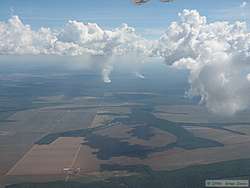 The flight itself offered a glimpse at a sad state of affairs in Brazil. We saw miles upon miles, not of trees, but of various agricultural fields. These were huge fields, sometimes bordered by patches of trees (usually along rivers or streams), but often existing in a James Joyce no punctuation fashion to some absurd limit. Often patches of remaining forest could be located by huge columns of smoke rising up from them, harbingers of the slash and burn agriculture made infamous in Brazil.
The flight itself offered a glimpse at a sad state of affairs in Brazil. We saw miles upon miles, not of trees, but of various agricultural fields. These were huge fields, sometimes bordered by patches of trees (usually along rivers or streams), but often existing in a James Joyce no punctuation fashion to some absurd limit. Often patches of remaining forest could be located by huge columns of smoke rising up from them, harbingers of the slash and burn agriculture made infamous in Brazil.
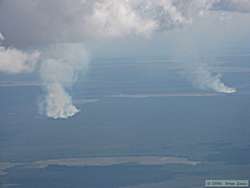 What's worse, from a personal standpoint, is that I was more clearly implicated in taking a part in the destruction than I ever could have imagined, by the bringing together of two pieces of the puzzle. In the Pantanal, we saw the huge barges carrying soy beans from Brazil to Argentina and learned that Brazil is the largest exporter of soy, but we saw no crops. From the plane, the source of the soy lay as bare as the ground itself.
What's worse, from a personal standpoint, is that I was more clearly implicated in taking a part in the destruction than I ever could have imagined, by the bringing together of two pieces of the puzzle. In the Pantanal, we saw the huge barges carrying soy beans from Brazil to Argentina and learned that Brazil is the largest exporter of soy, but we saw no crops. From the plane, the source of the soy lay as bare as the ground itself.
As a vegetarian, I consume quite a bit of soy, out of convenience as much as necessity. Now I could see the patch of rainforest that went under to the blade and torch for me. It was an important reminder that everything comes from somewhere and carries with it certain hidden costs. This simple fact is easy to lose sight of when everything you get comes from off a shelf. And in the shell game that is the current global economy, those hidden costs are obscene.
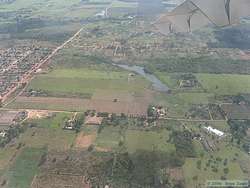 My only consolation was that as a vegetarian, at least those soybeans I ate consumed far less land than the cattle would have if I ate them. I discovered later that cattle ranching accounts for 60-70% of the deforestation of the Amazon, and that agro-industry (production of crops on a large scale as opposed to small or subsistence farmers) only accounts for about 2% of the deforestation. Still, the recollection of that sight continually reinforces my resolve to do what I can to minimize the impact I have on this big, beautiful earth.
My only consolation was that as a vegetarian, at least those soybeans I ate consumed far less land than the cattle would have if I ate them. I discovered later that cattle ranching accounts for 60-70% of the deforestation of the Amazon, and that agro-industry (production of crops on a large scale as opposed to small or subsistence farmers) only accounts for about 2% of the deforestation. Still, the recollection of that sight continually reinforces my resolve to do what I can to minimize the impact I have on this big, beautiful earth.
Our flight had a stop in Sinop which was thankfully brief. I kept looking out the window to make sure the carry-on I had to check in wasn't sitting out on the tarmac. The approach into Sinop was a pretty rough, and I wondered how Chuck was handling it. He probably left a few fingernails embedded into the arm rests.
On the flight, we met Larry and Carolyn, two Americans who were also going to the Rio Cristalino Jungle Lodge. We talked about where we'd been and what we'd seen in our travels around Brazil. They were hardcore birders, complete with very particular birds to add to what I imagine were extensive life lists. (A life list is a list that many birders keep of all of the birds they've seen, with a key goal to see as many different species as possible. Hardcore birders have been known to travel to far off countries to look for one particular species of bird.) While I kept a careful and complete list of everything I saw in Brazil, I don't keep a life list. Though I like to remember (or be reminded) of the species I've seen, life lists have the tendency to turn in to obsessions, and I don't want my forays into nature to be driven by so narrow a goal as seeing a single species.
Before long, we were in Alta Floresta. We were greeted at the airport by Zuleica and Scott. Zuleica is a Brazilian who the manager of the Hotel Floresta Amaz˘nica, and seems to serve as the hotel's chief greeter. Scott is an American who serves as a volunteer guide (working for tips with free room and board) at the Rio Cristalino Jungle Lodge. Being young, cute, and most importantly, blonde, Chuck took an immediate liking to Zuleica. I think he would have dodged the immigration police and stayed in Brazil permanently if she'd asked him to!
We all piled into a Land Rover and went to the Hotel Floresta Amaz˘nica to relax over some welcome drinks and a late lunch while Zuleica waited for all of our luggage. I was a bit nervous about my camera gear getting forgotten, but didn't make waves and crossed my fingers. It all worked out.
We were greeted at the hotel with suca de tamarindo, which was quite tasty. Since our luggage, and thus our binos and camera gear, had not arrived, we had lunch before going on a short hike on the hotel grounds to see some nesting harpy eagles (Harpia harpyja) and their nestling.
The Hotel Floresta Amaz˘nica is surrounded by a fair amount of primary rainforest (about 50 hectares, or 125 acres), with trails throughout. This makes the hotel a fairly attractive destination of its own. The owner of the hotel, and jungle lodge, Vitoria, seems committed to keeping a significant portion of her properties in a natural state, for which she gets my praise.
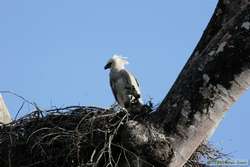 After lunch, we walked out to the harpy eagle nest, and ended up getting escorted by a guy who was doing some unpaid (and probably unguided, if not misguided) research on the eagles. He took us to a couple of wildlife blinds that had been constructed out of palm fronds. There we sat and watched the nestling in the nest. There was no sign of either of the adults, which isn't surprising due to the age of the nestling. It was old enough not to need constant care.
After lunch, we walked out to the harpy eagle nest, and ended up getting escorted by a guy who was doing some unpaid (and probably unguided, if not misguided) research on the eagles. He took us to a couple of wildlife blinds that had been constructed out of palm fronds. There we sat and watched the nestling in the nest. There was no sign of either of the adults, which isn't surprising due to the age of the nestling. It was old enough not to need constant care.
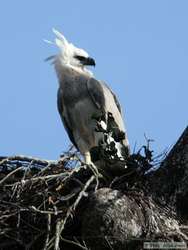 Harpy eagles are, by some measurements, the largest eagles in the world. They are not the biggest, but are apparently the heaviest and strongest.
Harpy eagles are, by some measurements, the largest eagles in the world. They are not the biggest, but are apparently the heaviest and strongest. 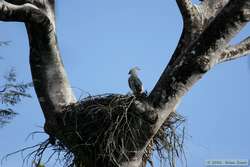 (Philippine eagles apparently hold the title for the largest eagles in the world in terms of physical dimensions.)
(Philippine eagles apparently hold the title for the largest eagles in the world in terms of physical dimensions.)
We would have watched it for quite a while, I suspect, hoping for the parents to return to the nest, but we had to get back to the hotel so we could leave on time to get to the jungle lodge for dinner.
From the hotel, it was about an hour drive to get to the boats awaiting us at Rio Teles Pires. The drive took us past pastures that Fabricio said were until very recently primary forest, once again reminding us that what we were seeing was under extreme threat and might not be around for future generations. The drive became a moment of contemplation for me. The loss of one of the greatest ecosystems of the world would be a sore one in more ways than anyone could imagine.
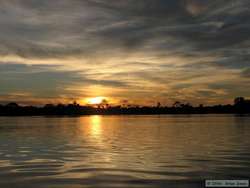
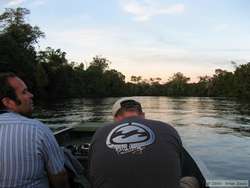 Being as it was dusk when we arrived at the river, we hurriedly loaded our gear onto the small aluminum boats and made our way across the Teles Pires to the mouth of Rio Cristalino. At the confluence of the two, the coffee waters of the Cristalino were slow to mix with the milk chocolate waters of the Teles Pires, the Cristalino fighting for its identity for quite a ways downstream before being subsumed by the inevitable mixing.
Being as it was dusk when we arrived at the river, we hurriedly loaded our gear onto the small aluminum boats and made our way across the Teles Pires to the mouth of Rio Cristalino. At the confluence of the two, the coffee waters of the Cristalino were slow to mix with the milk chocolate waters of the Teles Pires, the Cristalino fighting for its identity for quite a ways downstream before being subsumed by the inevitable mixing.
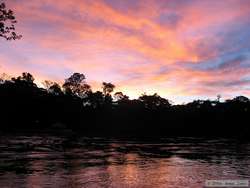 The sun set as we motored up the Rio Cristalino, offering a wonderful spectacle. We moored at the jungle lodge as darkness was setting in, and were instantly captivated by the place. We arrived once again to welcome drinks. After enjoying the drinks we were shown to our bungalows, which were spacious though basic, as they should be.
The sun set as we motored up the Rio Cristalino, offering a wonderful spectacle. We moored at the jungle lodge as darkness was setting in, and were instantly captivated by the place. We arrived once again to welcome drinks. After enjoying the drinks we were shown to our bungalows, which were spacious though basic, as they should be.
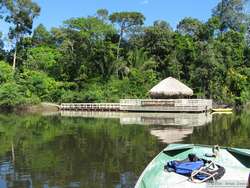 The room had tile floors, a couple of chairs with a side table, two twin beds, a ceiling fan (useable only when the generator was running), a bathroom with cool and cold running water, and screens instead of windows. We would later determine that our room had another guest; a gecko that liked to either perch high in the ceiling beams or on my bed. It was a daily routine to wipe at least one gecko poop off of my bed (usually on or very near my pillow), which I found rather entertaining. (I'm strange that way.)
The room had tile floors, a couple of chairs with a side table, two twin beds, a ceiling fan (useable only when the generator was running), a bathroom with cool and cold running water, and screens instead of windows. We would later determine that our room had another guest; a gecko that liked to either perch high in the ceiling beams or on my bed. It was a daily routine to wipe at least one gecko poop off of my bed (usually on or very near my pillow), which I found rather entertaining. (I'm strange that way.)
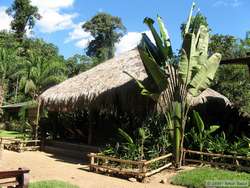
|
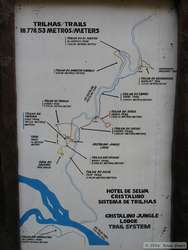
|
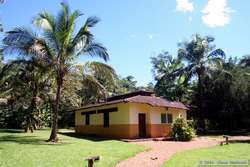
|
Species list for the day (7 birds, 1 mammal):
Anhinga (Anhinga anhinga)
Capped Heron (Pilherodius pileatus)
Striated Heron (Butorides striatus)
Harpy Eagle (Harpia harpyja)
White-winged Swallow (Tachycineta albiventer)
M Purple Martin (Progne subis)
White-banded Swallow (Atticora fasciata)
Jaguarundi (Felis yagouaroundi)
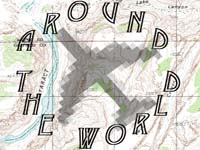 |
 |